I grew up in the New York City area. I’ve been to the city many times, and even held a few jobs there. But most of my experiences with the city are from the ground, where the view is somewhat restricted. For years I’ve been trying to get to the top of the Empire State Building for my birthday to get a better look at the city, but it seems like every year I try they schedule the annual race up the building’s staircase for the same day. This year, with my Private Pilot’s certificate in hand and a Universal Pilot Checkout from Open Airplane, I figured I would try something different for a better effect: rent a plane and fly it up the Hudson River SFRA.
I’ve already posted an article about all the pre-flight planning that I did for this little adventure, so if you’re curious about doing the same thing check that out and you can see all the work that needs to be done in advance to make it possible. Today’s story focuses specifically on the flight, and that story starts four days before takeoff.
I was sitting at my computer at work in San Antonio, Texas watching the forecast slowly deteriorate in New York. The city had been hit by a couple blizzards recently, and while I figured there would be some snow on the ground I hadn’t figured on there being snow in the air.
When I first checked about a week out, the forecast had called for clear skies and sunshine — a perfect day for flying. But as the day of the reservation came closer, the weather worsened. Four days from takeoff, the weather forecast was calling for overcast skies and a “wintry mix” of freezing rain and snow during my flight. In other words, perfect icing conditions. I had done all of my training in South Texas during the heat of the summer, so while I was happy sweating my butt off in the airplane and dealing with high density altitude conditions, this would be different. Icing wasn’t something that was common in my part of the world (at the altitudes I usually fly, anyway) and definitely something I wasn’t trained to handle.
The forecast was calling for temperatures well below freezing on the ground, no matter the type of precipitation. I knew that this meant I would have ice-cold fuel in my tanks and freezing cold wings, which was ideal conditions for impact ice to form on the wing in flight and vastly reduce the amount of lift I could get out of them. I also figured that if the weather happened before the flight, I wouldn’t be able to get enough of the ice and snow off of the wings to make them aerodynamic enough for proper flight.
Pilots talk about “get-there-itis” and the driving urge to complete their mission no matter the conditions, and I knew that this had a nasty habit of getting people killed. I’d never before felt this kind of pressure about a flight, especially since this was my one shot for everything to align. My friend had taken this specific day off from work, and would be annoyed if she didn’t get the flight. The airplane was scheduled for this day only, and might not be available again for the entirety of my trip to New York. And to top it all off, it was my birthday. Nevertheless I made a decision right then and there at my desk in Texas: if there was any precipitation anywhere in the area any time around my flight, I wouldn’t go.
Thankfully, over the next two days, the weather improved dramatically. The predicted storm weakened, and arrived earlier than forecast. We were good to go in terms of icing, but there was still a problem. Instead of icing conditions, we now had a pretty nasty wind condition. The forecast was calling for sustained winds of 15 knots gusting to 25, which normally would be outside my comfort zone except for one thing: the winds were straight down the runway. I’ve handled gusty winds before, but gusts + crosswind + unknown airplane + unfamiliar airport would have been too much.
Those straight-down-the-runway winds were going to be a problem later over the Hudson, since they were basically at a 90 degree angle to our flight path up the Hudson. The winds would be trying to blow us into the buildings of downtown Manhattan the entire time, but some wind correction with the heading of the airplane should set that straight. It’s just something I needed to be aware of.
Happy with the weather conditions, I set out to make the flight.
In order to make this flight safely, I figured I needed a second person with me in the cockpit. Not a pilot, but someone to run the cameras and take pictures. The Hudson River SFRA is a pretty wide road, but it is surrounded by some of the most complex and restrictive airspace in the United States. I wanted to be completely 100% focused on flying the airplane safely, and so I roped one of my friends into making the flight with me to act as my SO or “Selfie Officer.” I picked her up from her apartment in Queens around 9 am on the day of the flight, and then drove out to the airport.
Our reservation with the airplane wasn’t until 11 AM, but I wanted to get there early. This was my first time renting a plane with OpenAirplane, and while everything should “just work” I didn’t want to leave anything to chance. Plus, having more time to prepare and pre-flight is never a bad thing.
We arrived at Republic Airport (KFRG) a little after 10 AM, and checked in with the Academy of Aviation (the FBO / OpenAirplane operator we were using). The airplane we had rented was out being used for instruction, but was due to be back shortly. I used the time to sit down with my friend and go over the usual required safety briefing (how the seatbelt works, opening doors in the event of an emergency, positive exchange of flight controls, what to do if you get airsick… the usual), as well as show her the planned route of flight for the day.
A few minutes later one of the flight instructors walked into the shop, and the guy behind the desk sent us into a side room to have a quick chat about my planned flight. Part of the OpenAirplane deal is a section on the operator’s page that talks about the local procedures, and the flights are supposed to include an in-person briefing as well if possible. I feel like Academy of Aviation went above and beyond with this requirement though, as even from the moment I first contacted them they were giving me information I needed and helping me plan an appropriate flight plan.
My original flight plan sent me way out over the water to avoid the Class Bravo airspace around JFK. I could cut under the Bravo shelf along the shoreline if I was at 500 feet or less, but I didn’t know the local area very well and couldn’t figure out if there might be some obstacles in the way. The CFI let me know that flying along the shoreline was perfectly safe at those altitudes, and I should reconsider going along the shoreline instead of way out to sea. So I took his advice, and it probably saved me a good 10 to 15 minutes.
After the quick chat with the flight instructor, I felt like I had a better understanding of where I was flying and which frequencies to use to communicate. He seemed satisfied with my pre-flight planning, and released us to go have some fun in the air.
The ramp at Republic Airport is tightly controlled. Badges are required for access, and as out-of-town visitors we didn’t have no stinkin’ badges. The flight school informed us that the best way to get out to the plane and back without unnecessary hassle from the security guards was to wait for an escort from the FBO. For our trip out to the ramp, they drove us out in one of the employee’s cars — which was perfect. My companion was not happy about the below freezing temperatures and the windy conditions, and so sat in the car while I did the pre-flight inspection with the FBO employee. Happy with the general operation of the plane we fueled it up, then my friend hopped in and we taxied out to the end of runway 32.
I started IFR training not too long ago, and one of the first things they teach about is instrument failures. Specifically, a lot of time is put into drumming the failure modes into our heads and the need to check the instruments before flight. So as I was heading down the taxiway, I did a couple turns to make sure all the gyros were gyro-ing. The turn coordinator was perfect, but the attitude indicator was slumped on the bottom of the dial and the heading indicator wouldn’t budge. This plane had just flown, so I wanted to give it the benefit of the doubt and check again during the run-up to see if things would be better. As soon as the tach hit 1,800 RPM, the heading indicator started spinning (despite us being perfectly still) and the attitude indicator still hadn’t budged. The big orange “OFF” tab was nowhere to be seen so I knew it was getting some pressure, but not enough to spin the instrument and make it useful. And the vacuum indicator dial was just south of the green arc, which probably would have been OK in flight at 2,300 RPM but on the ground or with the engine at idle it was no good.
I had successfully diagnosed my first vacuum pump failure!
Here again, I had that hint of “get-there-itis.” I was sitting in an otherwise perfectly good airplane all set to go at the end of a runway, and I knew that I could fly the airplane without the attitude indicator or heading indicator and probably get away with it. I had no idea how the FBO would handle this situation, and it might mean that we wouldn’t get to complete our flight that day (or ever). But my training and (limited) experience was telling me to turn back, so I did.
We let the tower know that we had an instrument issue, and taxied back to the ramp. Once there I called the FBO and let them know what had happened. They were extremely helpful and immediately ran a new set of keys out for a different Cessna 172 of theirs, one that was a little older and a little more beaten up but was nevertheless serviceable. After a pre-flight inspection and double checking the contents and level of the fuel tanks, we hopped on board and set off.
After departure from Republic, we were handed off to New York Approach and then to Kennedy Tower. The Class Bravo airspace around JFK south of the shoreline starts at 500 feet MSL, so the CFI at the FBO had suggested that we fly along the shoreline right around 300 feet off the deck. The FAA doesn’t dictate a definitive “minimum safe altitude” for operations, just that the aircraft be more than 500 feet offshore but high enough to be able to land if the engine quits. 250 to 300 was perfectly adequate for that purpose as we hugged the shoreline, and it gave us some incredible views.
I was initially nervous about flying so low (and perfectly willing to bust out the “declaring an emergency” card to get through the Bravo and back up to a higher altitude if anything went wrong), but it was actually very pleasant. My IFR training has had me focusing on flying a more precise path through the sky and holding altitude more exactly, and I had no problems doing that even given the proximity to the waves.
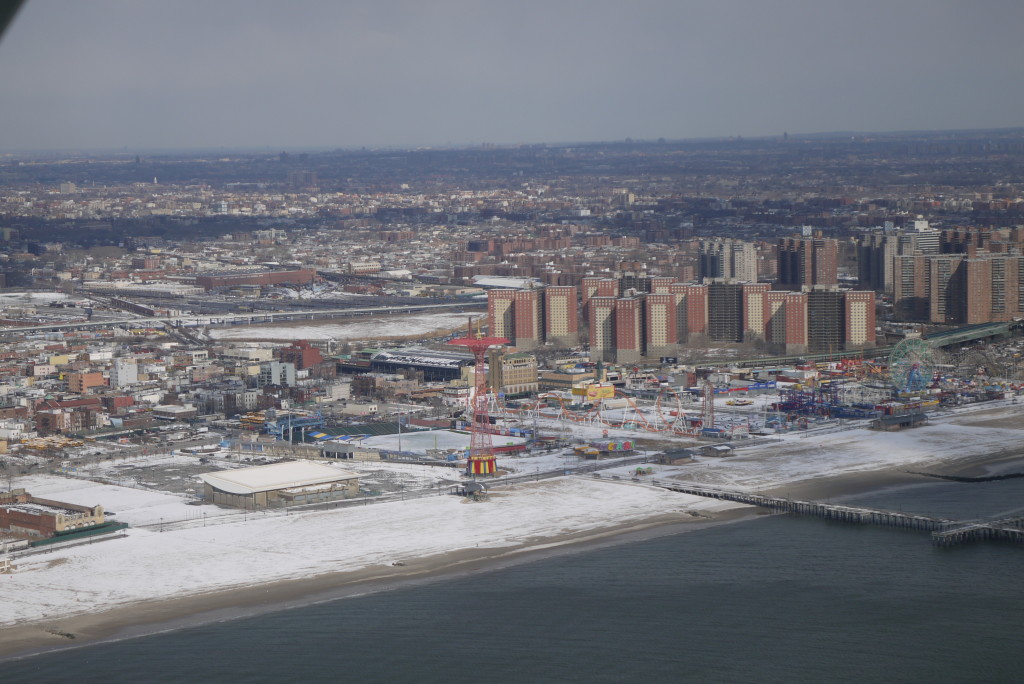
The one variable I hadn’t encountered before was wake turbulence. Since we were going to be passing directly below the approach for both Kennedy and LaGuardia, we would be hitting the wake turbulence from everything from a Cessna 172 to an Airbus A380 as we passed through the area. I had considered it during my pre-flight analysis and had made my passenger aware of the phenomenon we would be encountering (and shoved some Dramamine down her throat as well for good measure), but I didn’t really know how bad it would be. It wasn’t something I had ever encountered before, and while I had run this same route in Microsoft Flight Simulator X a few times and seen the effect on the screen, I had no idea how it would actually feel.
The first time we encountered wake turbulence, it was a bit of a shock. We had been rocking and rolling thanks to the gusty headwinds already, but the wake turbulence from above shoved us a good 30 feet towards the deck. Needless to say I altered my flight path a little further skyward after that one, but it actually wasn’t as bad as I feared it would be. It was more like hitting a pothole in the sky every once in a while rather than any real traumatic event.
Not something I would want to handle on takeoff or landing, but perfectly acceptable in cruise for short periods.
Rounding out around the tip of Long Island, the Verrazano Bridge was the first checkpoint in the Hudson River SFRA. After clearing the edge of JFK’s Bravo airspace I climbed up to 1,100 feet and configured the airplane for the ride past New York. The “transient operation” band for the Hudson River SFRA runs from 1,000 feet MSL to 1,299 MSL, and above that is the New York Class Bravo airspace. Go too low and you hit some helicopters. Go too high and you hit the Bravo and get a nasty letter from the FAA and possibly lose your certificate. It’s definitely the most constrained airspace I’ve ever flown in, and I chose to run at 1,100 to give me a little wiggle room on either side before hitting any dangerous airspace.
I calculated the clearance distances at that altitude for the bridges that we were crossing and I figured we would be OK, but I still decided to deviate from the flight path a little to fly through the center of the span rather than directly over the pylons. Technically a no-no, but I’d rather have to explain myself to the FAA than St. Peter.
Once we were in the groove, the flight was absolutely beautiful.
Without a doubt, the hardest part about flying through the Hudson River SFRA is keeping your eyes on the road. I wanted to enjoy the view, but with the constant crosswind and the gusty conditions I needed to keep my focus squarely on the flight and keeping the plane straight and level. It made me happy that I had decided to bring someone along specifically to record the flight for me so I could enjoy it later, and the resulting video is absolutely amazing.
Listening on the CTAF, there was a ton of helicopter traffic and they definitely were not happy to see me. I think I heard one person complain about the “slow moving Cessna” that was in his way, but I was properly announcing my position along the route and maintaining my altitude as required. I did consider dropping down for a loop around the Statue of Liberty, but since I had enough going on with the flight as it was I decided against that particular stunt. Maybe next time.
After passing through the SFRA and exiting along the top edge of LGA’s Class Bravo, I tried to contact New York Approach for flight following. The problem was that New York Approach wasn’t listening on the frequency published on the charts. After a couple attempts I tried LaGuardia Tower who helpfully gave me a different frequency to try, but it was still the wrong one and was passed to a third frequency. After finally picking up flight following I crossed the Long Island Sound faster than I ever have before (it was in a sailboat last time) and arrived back at Republic for a (mostly) on-time arrival.
The field at Republic had been experiencing high winds all day, and as a result the large snowbanks on the sides of the tarmac had been drifting onto the runway. It had gotten so bad that the runway markings had been obscured, and I started having trouble orienting myself at the unfamiliar airport. The obscured markings, combined with my inexperience at that airport and some confusing discussions with the tower controller, led me to line up for a final approach to the wrong runway — runway 1 instead of runway 32. With the snow on the runway, the number “1” looked like just another stripe and the runway end markings were completely obscured, so I didn’t figure out my mistake until the controller gently informed me that I was in the wrong place. I apologized profusely, checked my GPS, reset my well-processed heading indicator, and made an extremely smooth landing on runway 32 a couple minutes later.
(Just a note: I went home and wrote up that last issue on the NASA reporting website. A little CYA, as well as some helpful information for the FAA about runway markings hopefully).
In the end, it was an absolutely beautiful flight. The FBO was very nice and extremely helpful. OpenAirplane was easy to use and even sent out some reminders. And the video I got from the trip was spectacular. And to top it all off, my passenger didn’t get airsick! It was, without a doubt, the best birthday I ever had.
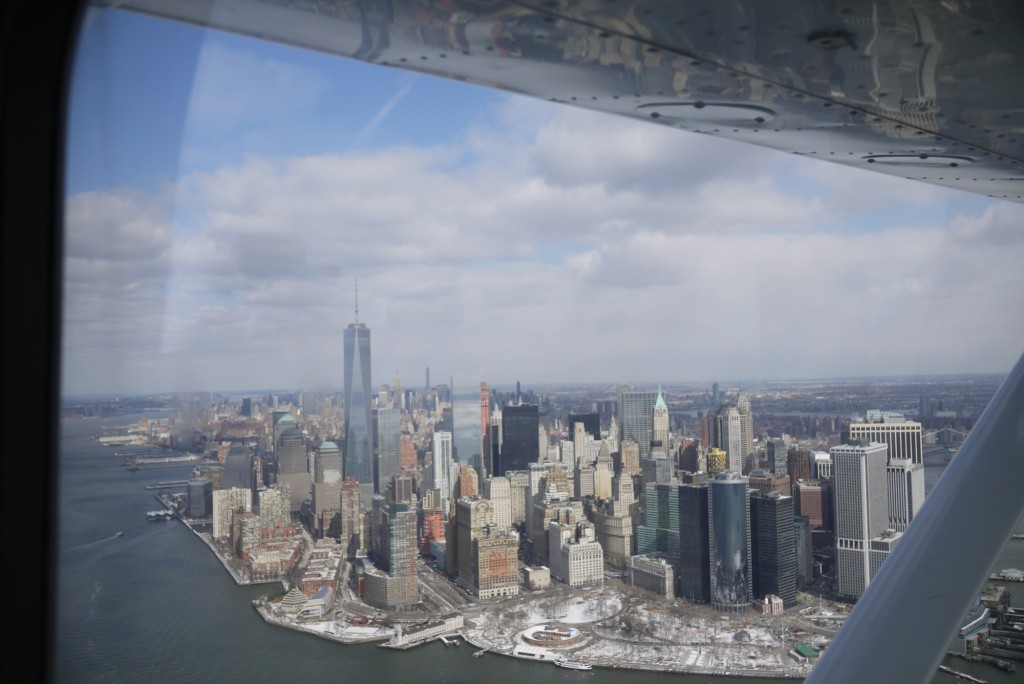
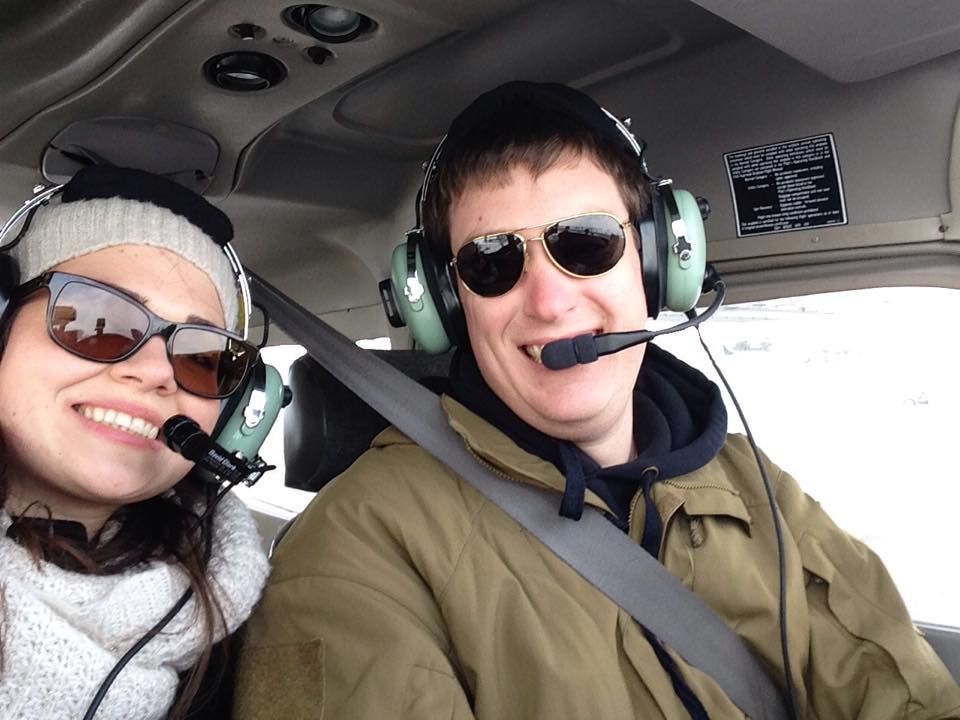
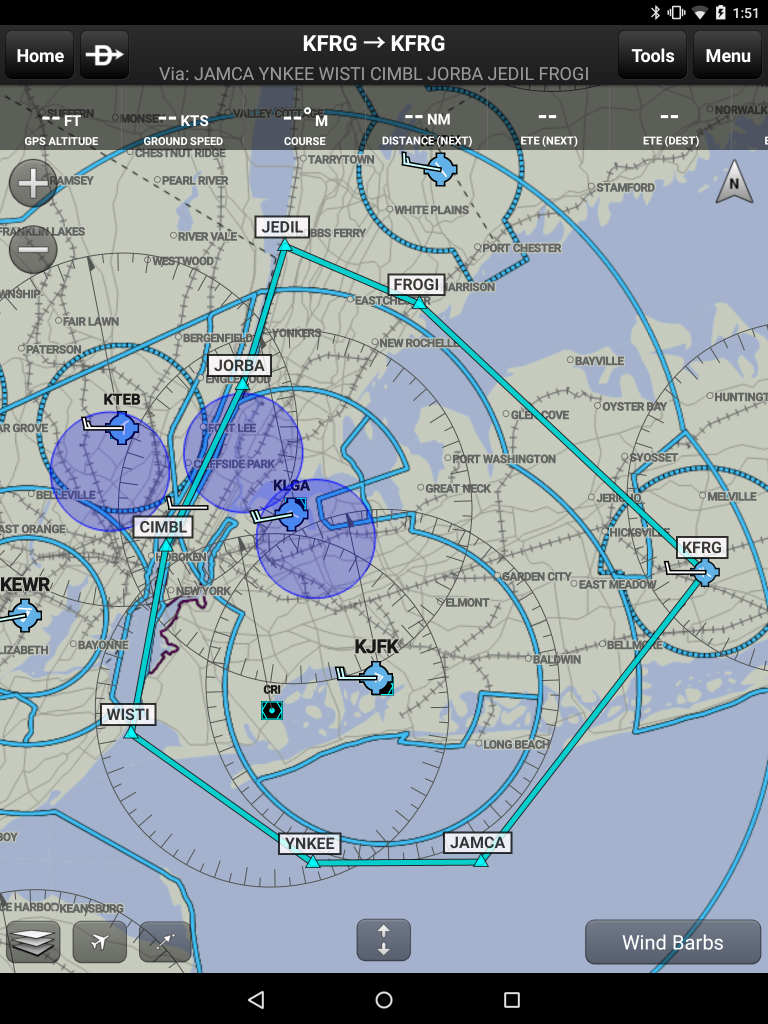
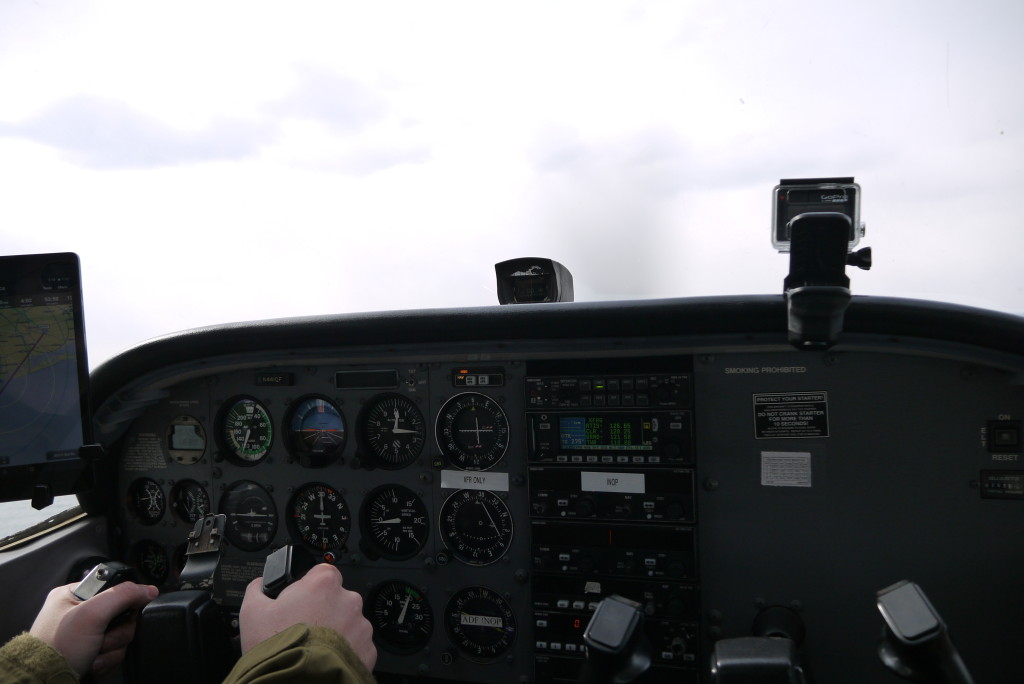
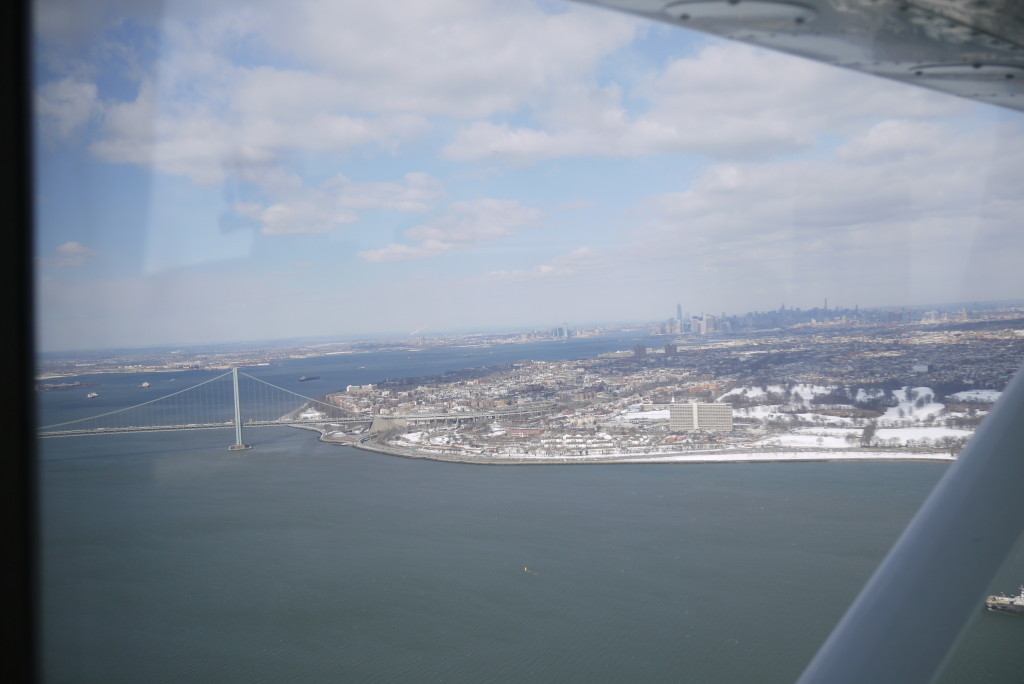
Congratulations on making it happen! The Hudson is one of the most surreal places to fly. Well done and thanks for sharing the video.
Thank you for sharing. I’ve just planned to do the exact same flight for my birthday next month, via open airplane and Academy and I found your article looking for info about the SFRA. It is seriously useful. Could you please tell me which app are you using as GPS?
Congratulations on your great flight and article.
Thanks for the kind words!
I’m using a Dual Electronics XGPS150A external bluetooth GPS, reviewed here:
https://www.takeoffjunkie.com/review-dual-electronics-xgps150a-bluetooth-gps/
That’s hooked up to a Nexus 9 tablet running Garmin Pilot. Garmin Pilot review here:
https://www.takeoffjunkie.com/review-garmin-pilot-for-android/